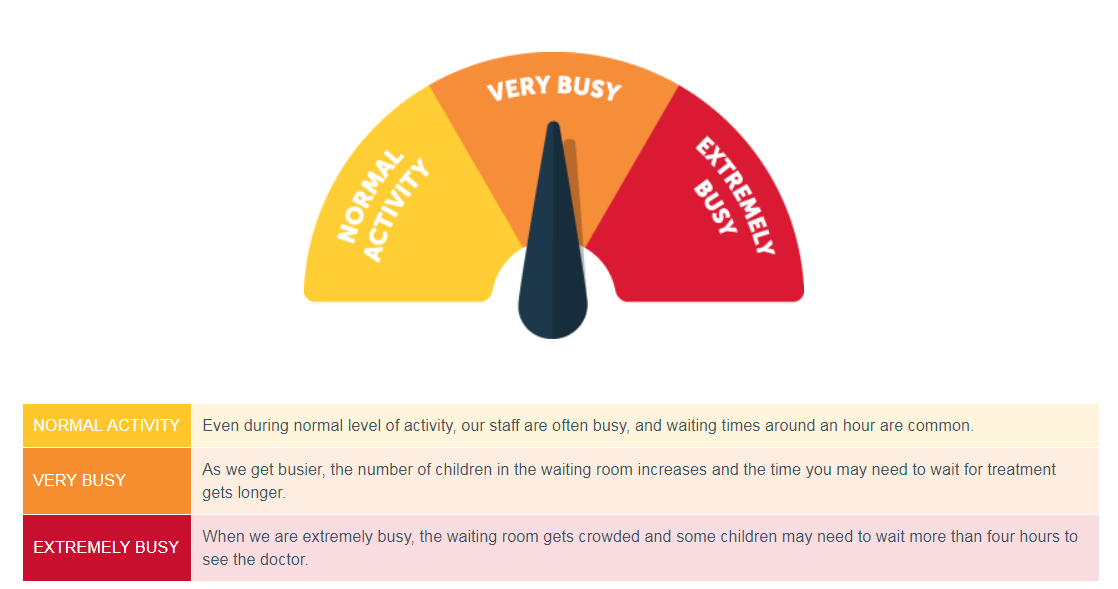Melbourne children's hospital emergency department gets real-time wait updates

The Royal Children's Hospital Melbourne's emergency department digital dial.
The Royal Children's Hospital Melbourne (RCHM) has released an online tracker that gives real-time information about wait times in their emergency department (ED) 24 hours a day.
The tracker, unveiled on Thursday by Premier Daniel Andrews and Minister for Health Jill Hennessy, rates activity as normal, very busy, or extremely busy on a dial. The portal is aimed to help parents decide whether to take their children to a local hospital or GP instead of the ED.
According to the Victorian government, data shows over 60 percent of parents currently bypass their local hospital to attend the ED, which can result in crowds and long delays for patients with less serious illnesses or injuries.
The tracker aims to alleviate this, as well as reduce calls to the ED, 80 percent of which are to gauge wait times, according to Hennessey. The hospital treated 17,468 patients in the quarter ending March, up from 17,361 last year.
"Long waits can be frustrating -- so by giving families real-time information about the status of the emergency department, the Victorian government is giving patients the treatment they need faster and making the emergency department safer for hardworking health care staff," the department said in a release.
RCHM has also received funding for extra short stay capacity, the state government said, and is among the 17 of Victoria's biggest health services to have received part of AU$50 million in funding going into the winter.
Victoria's 2018-19 Budget has included AU$2.1 billion to boost healthcare. The Department of Health and Human Services is getting AU$12 million in 2018-19 for a clinical technology refresh, as well as funding for electronic medical records in Parkville: AU$22.7 million in 2018-19, followed by AU$55.1 million in 2019-20 and AU$46 million in 2020-21.
The state government has also set aside AU$32.9 million in funding to improve science, technology, engineering, and mathematics (STEM) outcomes in schools -- AU$8.2 million for 2018-19, AU$16.6 million in 2019-20, and AU$8.1 million in 2020-21.
With AAP
PREVIOUS AND RELATED COVERAGE
https://www.zdnet.com/article/samsung-sk-telecom-launch-lte-r-service/
https://www.zdnet.com/article/samsung-sk-telecom-launch-lte-r-service/
Health holds crown as the most breached sector in Australia
The Office of the Australian Information Commissioner has received 63 data breach notifications in first six weeks of the scheme's operation.
Cancelled My Health Record data to be kept in limbo
Those choosing to opt-out of the My Health Record service will still have their data visible if they reactivate their account.
Healthcare's $3 trillion question: Should the likes of Google and Facebook control this data?
How is data managed? Do users get to have consent over how their data is used? And do they get a cut out of the value generated by using that data? Let's take a walk on the wild side.
5 ways technology will change the future of healthcare(TechRepublic)
https://www.techrepublic.com/article/5-ways-technology-will-change-the-future-of-healthcare/The healthcare industry is in a state of flux. Mike Strazzella, a federal government healthcare attorney, shares his expectations for how technology and new regulations will shape the future of care.
https://www.techrepublic.com/article/5-ways-technology-will-change-the-future-of-healthcare/A smart toilet may be the future of IoT healthcare(TechRepublic)
Revon CEO Ted Smith explains why data scientists, medical specialists, and developers are all vital to the healthcare industry's digital transformation.
